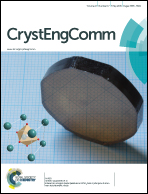Ab initio modeling of single wall nanotubes folded from α- and γ-V2O5 monolayers: structural, electronic and vibrational properties
Abstract
We have performed first-principles calculations to study the atomic and electronic structures of single wall nanotubes (NTs) of two possible chirality types rolled up from monolayers of α- and γ-V2O5 phases. We have used a hybrid exchange–correlation PBE0 functional within density functional theory and a basis set of localized atomic orbitals. A dispersion correction has been taken into account. All the lattice parameters and atomic positions have been totally optimized. The strain energies calculated for the nanotubes folded from the layers of both phases along the [100] direction are close to zero. This reflects the unique flexibility of the layers for folding in the [100] direction. The electronic structure of the nanotubes of both phases appeared to be similar to that of the parent layer. It was found that for both considered phases, the nanotubes of the same chirality are energetically equivalent but the shape of γ-NTs is closer to the cylindrical form than that of α-NTs. Young's moduli calculated for (6,0) α- and γ-NTs were found to be 172 GPa and 148 GPa, respectively. The phonon mode frequencies of (6,0) α- and γ-NTs have been calculated and compared with those of α- and γ-V2O5 free layers.


 Please wait while we load your content...
Please wait while we load your content...